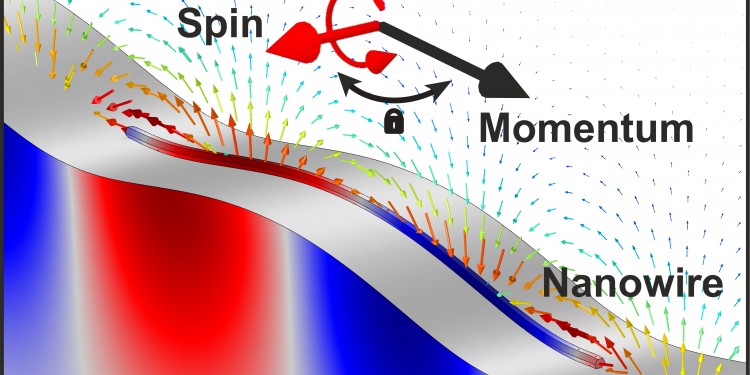
Spin-sonics: Acoustic wave gets the electrons spinning
A team of German and American researchers from Augsburg, Münster, Edmonton, West Lafayette and Munich have detected the rolling movement of a nano-acoustic wave predicted by the famous physicist and Nobel prize-winner Lord Rayleigh in 1885. In a study published in the journal "Science Advances", the researchers use a nanowire inside which electrons are forced onto circular paths by the spin of the acoustic wave. This phenomenon can find applications in acoustic quantum technologies or in so-called phononic components which are used to control the propagation of acoustic waves.
Acoustic waves are incredibly versatile in modern nanophysics, as they can influence both electronic and photonic systems. For example, minute micro-acoustic chips in computers, smartphones or tablets ensure that the wireless signals received are electronically processed. However, despite the wide-ranging uses to which nano-acoustic waves can be put, the fundamental property of spin of the nano-acoustic wave was never detected till date.
"Since Lord Rayleigh’s pioneering work it has been known that there are acoustic waves which propagate on the surface of solids and which show a highly characteristic elliptical rolling movement," explains Dr. Hubert Krenner, a Professor Physics, who headed the study at the University of Augsburg and recently moved to the University of Münster. "In the case of nano-acoustic waves we have now succeeded in observing directly this transversal spin, which is what we physicists call this movement."
In their study, the researchers used an extremely fine nanowire which was positioned on a so-called piezoelectric material - Lithium Niobate. This material becomes deformed when subjected to an electrical current, and, with the aid of small metal electrodes, an acoustic wave can be generated on the material. On the surface of the material, the acoustic wave generates an elliptically rotating (gyrating) electrical field. This, in turn, forces the electrons in the nanowire onto circular paths. Prof. Zubin Jacob, from Purdue University, is excited about the result. "So far we knew about this phenomenon for light," he says, "Now we have succeeded in demonstrating that this is a universal effect which also occurs in other types of waves such as sound waves on a technologically important platform - Lithium Niobate."
The research results presented are a milestone, as the transversal spin now observed for the first time can be used specifically to control nano-systems or transfer information. As Maximilian Sonner, a PhD student at the Institute of Physics at Augsburg, explains, "We observe the movement of electrons in the nanowires, which were made at the Technical University of Munich, through the light emitted by the electrons." His colleague Dr. Lisa Janker adds, "We use an extremely rapid stroboscope here which enables us to practically observe this movement in real time – even at higher frequencies up to the gigahertz range."
Dr. Farhad Khosravi, who recently completed his PhD in Zubin Jacob’s research group, says, "I was able to transfer my calculations for light directly to the Rayleigh acoustic wave. It has been known for a long time that light waves and sound waves have similar properties. Nevertheless, the extent of the match for their spin properties is really phenomenal."
The researchers are convinced that the universal principle of spin-physics underlying this phenomenon will lead to important technological advances. "The study which has now been published in Science Advances is just a first step – but a decisive one," says Hubert Krenner. The researchers are now working hard to link the transversal spin of acoustic waves with the spin of other waves. "What we need to do next," says Zubin Jacob, "is use this transversal acoustic spin specifically in order to manipulate optical quantum systems or the spin of light, for example."
In Germany the project was funded by the German Research Foundation (DFG) through the KR3790/6-1 and KO4005/6-1 projects; in the USA it received funding through the DARPA Nascent Light-Matter Interactions programme.
Original publication:
M. M. Sonner, F. Koshrawi, L. Janker, D. Rudolph, G. Koblmüller, Z. Jacob, H. J. Krenner (2021): Ultrafast electron cycloids driven by the transverse spin of a surface acoustic wave. Science Advances 7; DOI: 10.1126/sciadv.abf7414
